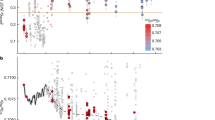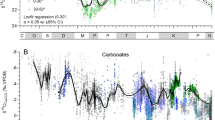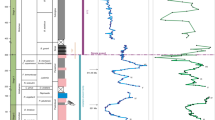Abstract
Many aspects of the carbon cycle can be assessed from temporal changes in the 13C/12C ratio of oceanic bicarbonate. 13C/12C can temporarily rise when large amounts of 13C-depleted photosynthetic organic matter are buried at enhanced rates1, and can decrease if phytomass is rapidly oxidized2 or if low 13C is rapidly released from methane clathrates3. Assuming that variations of the marine 13C/12C ratio are directly recorded in carbonate rocks, thousands of carbon isotope analyses of late Precambrian examples have been published to correlate these otherwise undatable strata and to document perturbations to the carbon cycle just before the great expansion of metazoan life. Low 13C/12C in some Neoproterozoic carbonates is considered evidence of carbon cycle perturbations unique to the Precambrian. These include complete oxidation of all organic matter in the ocean2 and complete productivity collapse such that low-13C/12C hydrothermal CO2 becomes the main input of carbon4. Here we compile all published oxygen and carbon isotope data for Neoproterozoic marine carbonates, and consider them in terms of processes known to alter the isotopic composition during transformation of the initial precipitate into limestone/dolostone. We show that the combined oxygen and carbon isotope systematics are identical to those of well-understood Phanerozoic examples that lithified in coastal pore fluids, receiving a large groundwater influx of photosynthetic carbon from terrestrial phytomass. Rather than being perturbations to the carbon cycle, widely reported decreases in 13C/12C in Neoproterozoic carbonates are more easily interpreted in the same way as is done for Phanerozoic examples. This influx of terrestrial carbon is not apparent in carbonates older than ∼850 Myr, so we infer an explosion of photosynthesizing communities on late Precambrian land surfaces. As a result, biotically enhanced weathering generated carbon-bearing soils on a large scale and their detrital sedimentation sequestered carbon5. This facilitated a rise in O2 necessary for the expansion of multicellular life.
This is a preview of subscription content, access via your institution
Access options
Subscribe to this journal
Receive 51 print issues and online access
$199.00 per year
only $3.90 per issue
Buy this article
- Purchase on Springer Link
- Instant access to full article PDF
Prices may be subject to local taxes which are calculated during checkout




Similar content being viewed by others
References
Scholle, P. A. & Arthur, M. A. Carbon isotope fluctuations in Cretaceous pelagic limestones: potential stratigraphic and petroleum exploration tool. Am. Assoc. Petrol. Geol. Bull. 64, 67–87 (1980)
Fike, D. A., Grotzinger, J. P., Pratt, L. M. & Summons, R. E. Oxidation of the Ediacaran Ocean. Nature 444, 744–747 (2006)
Jiang, G. Q., Kennedy, M. J. & Christie-Blick, N. Stable isotopic evidence for methane seeps in Neoproterozoic postglacial cap carbonates. Nature 426, 822–826 (2003)
Hoffman, P. F., Kaufman, A. J., Halverson, G. P. & Schrag, D. P. A Neoproterozoic snowball earth. Science 281, 1342–1346 (1998)
Kennedy, M., Droser, M., Mayer, L. M., Pevear, D. & Mrofka, D. Late Precambrian oxygenation; inception of the clay mineral factory. Science 311, 1446–1449 (2006)
Land, L. S. Limestone diagenesis — some geochemical considerations. US Geol. Surv. Bull. 1578, 129–137 (1986)
Melim, L. A., Swart, P. K. & Maliva, R. G. in Subsurface Geology of a Prograding Carbonate Platform Margin, Great Bahama Bank: Results of the Bahamas Drilling Project Vol. 70 (ed. Ginsburg, R.N.) 137–161 (SEPM, 2001)
Quinn, T. M. Meteoric diagenesis of Plio-Pleistocene limestones at Enewetak Atoll. J. Sedim. Petrol. 61, 681–703 (1990)
Gross, M. G. & Tracey, J. I. Oxygen and carbon isotopic composition of limestones and dolomites, Bikini and Eniwetok Atolls. Science 151, 1082–1084 (1966)
Banner, J. L. & Hanson, G. N. Calculation of simultaneous isotopic and trace-element variations during water-rock interaction with applications to carbonate diagenesis. Geochim. Cosmochim. Acta 54, 3123–3137 (1990)
Taylor, K. G., Gawthorpe, R. L., Curtis, C. D., Marshall, J. D. & Awwiller, D. N. Carbonate cementation in a sequence-stratigraphic framework: Upper Cretaceous sandstones, Book Cliffs, Utah-Colorado. J. Sedim. Res. 70, 360–372 (2000)
Hendry, J. P., Wilkinson, M., Fallick, A. E. & Haszeldine, R. S. Ankerite cementation in deeply buried Jurassic sandstone reservoirs of the central North Sea. J. Sedim. Res. 70, 227–239 (2000)
Fayek, M. et al. In situ stable isotopic evidence for protracted and complex carbonate cementation in a petroleum reservoir, North Coles Levee, San Joaquin Basin, California, USA. J. Sedim. Res. 71, 444–458 (2001)
Hathaway, J. C. et al. United States Geological Survey core drilling on the Atlantic Shelf. Science 206, 515–527 (1979)
Moore, W. S. S. a. r. m. i. e. n. t. o. J. L. & Key, R. M. Submarine groundwater discharge revealed by 228Ra distribution in the upper Atlantic Ocean. Nature Geosci. 1, 309–311 (2008)
Brooks, S. M. & Whitaker, F. F. Geochemical and physical controls on vadose zone hydrology of Holocene carbonate sands, grand Bahama Island. Earth Surf. Process. Landforms 22, 45–58 (1997)
Bristow, T. F. & Kennedy, M. J. Carbon isotope excursions and the oxidant budget of the Ediacaran atmosphere and ocean. Geology 36, 863–866 (2008)
Pokrovskii, B. G., Melezhik, V. A. & Bujakaite, M. I. Carbon, oxygen, strontium, and sulfur isotopic compositions in late Precambrian rocks of the Patom Complex, central Siberia: Communication 2. Nature of carbonates with ultralow and ultrahigh δ13C values. Lithol. Miner. Res. 41, 576–587 (2006)
Fairchild, I. J. & Spiro, B. Carbonate minerals in glacial sediments: geochemical clues to palaeoenvironment. Geol. Soc. Lond. Spec. Publ. 53, 201–216 (1990)
Muehlenbachs, K. The oxygen isotopic composition of the oceans, sediments and the seafloor. Chem. Geol. 145, 263–273 (1998)
Horodyski, R. J. & Knauth, L. P. Life on land in the Precambrian. Science 263, 494–498 (1994)
Heckman, D. S. et al. Molecular evidence for the early colonization of land by fungi and plants. Science 293, 1129–1133 (2001)
Prave, A. R. Life on land in the Proterozoic: evidence from the Torridonian rocks of northwest Scotland. Geology 30, 811–814 (2002)
Yuan, X. L., Xiao, S. H. & Taylor, T. N. Lichen-like symbiosis 600 million years ago. Science 308, 1017–1020 (2005)
Kaufman, A. J., Knoll, A. H. & Awramik, S. M. Biostratigraphic and chemostratigraphic correlation of Neoproterozoic sedimentary successions-Upper Tindir Group, Northwestern Canada as a test case. Geology 20, 181–185 (1992)
Canfield, D. E. The early history of atmospheric oxygen: homage to Robert A. Garrels. Annu. Rev. Earth Planet. Sci. 33, 1–36 (2005)
Lenton, T. M. & Watson, A. J. Biotic enhancement of weathering, atmospheric oxygen and carbon dioxide in the Neoproterozoic. Geophys. Res. Lett. 31 L05202 10.1029/2003GL018802 (2004)
Schwartzman, D. Life, Temperature, and the Earth (Columbia Univ. Press, 1999)
Acknowledgements
We thank K. McFadden for help compiling the data. L.P.K. was funded by NASA Exobiology grants NG04GJ47G and NNX08AT72G. M.J.K. was funded by NASA Exobiology NNG04GJ42G and NSF EAR 0345207.
Author Contributions Both authors shared equally in interpretations and implications of the data. L.P.K. compiled the data, wrote the initial draft, and managed revisions.
Author information
Authors and Affiliations
Corresponding author
Supplementary information
Supplementary Information
This file contains Supplementary Methods and References for data in Figures 1-4. (PDF 244 kb)
Supplementary Data
This file contains data used to compile Figures 1-4. (XLS 1490 kb)
Rights and permissions
About this article
Cite this article
Knauth, L., Kennedy, M. The late Precambrian greening of the Earth. Nature 460, 728–732 (2009). https://doi.org/10.1038/nature08213
Received:
Accepted:
Published:
Issue Date:
DOI: https://doi.org/10.1038/nature08213
This article is cited by
-
Sulfate triple-oxygen-isotope evidence confirming oceanic oxygenation 570 million years ago
Nature Communications (2023)
-
Global and regional controls on carbon-sulfur isotope cycling during SPICE event in south China
Frontiers of Earth Science (2023)
-
Spatiotemporal variation of dissolved oxygen in the Ediacaran surface ocean and its implication for oceanic carbon cycling
Science China Earth Sciences (2023)
-
The origin of a land flora
Nature Plants (2022)
-
Insight to the genetic diversity of pigeon pea Cajanus cajan (L.) Millsp. and cowpea Vigna unguiculata (L.) Walp. germplasm cultivated in Nigeria based on rbcl gene region
Genetic Resources and Crop Evolution (2022)
Comments
By submitting a comment you agree to abide by our Terms and Community Guidelines. If you find something abusive or that does not comply with our terms or guidelines please flag it as inappropriate.



